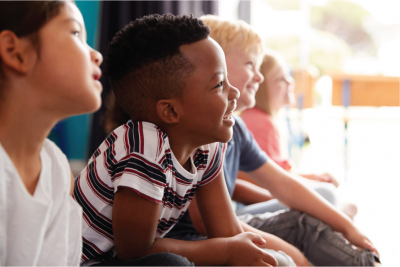- Benchmark Education
- Newmark Learning
- Reycraft Books
- Create an Account
Hispanic Heritage Month: 4 Ideas to Explore Centuries-Old Hispanic American History and Culture with Your Students

by Dr. Aradhana Mudambi
In 1968, Congress requested that President Lyndon B. Johnson declare the week starting on September 15 as Hispanic Heritage Week and urged educators to use the week to honor the histories, contributions, and influence of those Americans who could trace their heritage back to Spain or other Spanish-speaking countries. Twenty years later, President Ronald Reagan extended this commemoration from a week to a month. Since then, September 15 to October 15 has marked for nation-wide and local celebrations that honor our Hispanic communities.
Often these celebrations focus on recent immigration. However, while it is important to shed light on this immigration, we often forget that the Hispanic community has had a long presence in the history of what is today the United States. In fact, in 1989, upon the commencement of the first Hispanic Heritage Month, President George H. Bush reminded us of the need to honor this history through his statement, “Ever since Hispanic explorers… (came)... nearly half a millennium ago, men and women of Spanish and Latin American descent have made major contributions to the development of our country.” Hence, this year, let us focus on helping our students understand the long-standing impact that Hispanic communities have had on our nation.
1. Explore Historic St. Augustine, FL
Our students usually learn that the English settlements of Plymouth and Jamestown were the beginning of colonial America, thereby cementing the Anglo-Saxons’ foundational role in U.S. history; however, St. Augustine, Florida, established in 1565 by the Spaniards is the oldest, continuous European settlement in the present-day United States. Spanish conquistador Ponce de León, while supposedly searching for a fabled fountain of youth, saw Florida for the first time in 1513 and claimed it as Spanish territory. After various unsuccessful attempts by the Spanish to establish a permanent Spanish settlement in this new territory, Spanish admiral Don Pedro Menéndez de Aviles successfully founded St. Augustine. This was nearly 50 years before the British founded their previously mentioned towns. St. Augustine went on to have a marked influence on American history. For instance, in the 1700s, St. Augustine, under the Spanish crown, became a refuge for enslaved African Americans who were escaping the British colonies, and St. Augustine became a focal point for the early Underground Railroad.
This year, take your students on a virtual field trip to St. Augustine. Are they surprised to know that the British did not establish the first, permanent European settlement? Why do they think it is important for us to know about St. Augustine? Does this knowledge change our perceptions about the Hispanic community in the United States?
Resources: First Colony: Our Spanish Origins (Archeological Dig of Old St. Augustine), St. Augustine - 450 - The Story of St. Augustine’s People, History Behind the Fountain of Youth, Inspector Gadget’s Field Trip: Florida, St. Augustine
2. Listen to Folkloric, Hispano Music from New Mexico
When the Spanish established New Mexico as a royal colony in the late 16th and early 17th centuries, they brought to New Mexico a rich musical tradition with Christian, Jewish, and Muslim influences. Native Pueblo music, which had origins as far back as the 13th century, mixed with the music brought from Spain to create a novel New Mexican musical style. This new folk music shaped New Mexican society. For example, the lyrics chronicled and celebrated daily life in New Mexico. Furthermore, knowing that theatrical performances were characteristic of Indigenous cultures, missionaries combined the music with religious plays as an attempt to convert Native peoples to Christianity. And musicians performed Hispano music at important cultural events such as marriages and funerals. Since then, the distinctively New Mexican music has continued to play an important role in the region.
This Hispanic Heritage Month, listen to traditional Hispano folk music with your students. Ask your students why they think Hispano music became such an important part of the regional culture. What distinct features do they hear in New Mexican folkloric music that they don’t hear in other music? What are some commonalities between New Mexican folkloric music and the music your students routinely enjoy?
Resources: Cipriano Vigil Explains New Mexican Music, Entriega de Novios (Wedding Music), Los Comanchitos, Mañanitas Tapatias
3. Experience Puerto Rican Culture
Puerto Rico, a small tropical island in the Caribbean, had been a Spanish colony since Christopher Columbus claimed it for the Spanish crown in 1493. For 400 years, the Spanish language and culture took root on the island. However, the United States won Puerto Rico from Spain in the Spanish American War of 1898; in 1917, all Puerto Ricans became American citizens. Therefore, Puerto Rico’s centuries-long history and heritage became American history and heritage; from then on, Puerto Ricans who moved from the island to the mainland United States were no longer considered immigrants.
Puerto Ricans have had a tremendous impact on mainland American culture. For instance, many historians believe that Puerto Ricans imported racial tolerance to the mainland due to their mixed-race heritage (White, Black, and Taíno). Furthermore, Puerto Rico is a popular tourist destination for mainland Americans. Finally, while salsa originated in Cuba, Puerto Ricans popularized the dance in the United States. Today, salsa dancing is popular at weddings and events throughout the country.
Experience Puerto Rico and its culture with your students. Have students debate whether they believe Puerto Rico should become the 51st U.S. state. Listen to The Legend of the Coquí. Is it similar to any children’s stories your students have heard growing up? What are some of the similarities and differences between Puerto Rico’s bomba and salsa dances? How easy do students find learning how to salsa? How does it compare to how they usually dance? Why do they think it became so popular on the mainland?
Resources: History of Puerto Rico, The Legend of the Coquí, Puerto Rico’s Bomba, Salsa Tutorial for Kids, Dance to New York Puerto Rican Salsa Music
Learn About Chicano Civil Rights Issues
In 1848, the United States and Mexico signed the Treaty of Guadalupe-Hidalgo to end the Mexican-American War. Mexico lost most of its northwestern territory to the United States. However, the United States promised that Hispanics who lived on the United States side of the border would not lose their land rights, would be granted all of their civil rights as American citizens, and would be able to freely speak their language. Nevertheless, the United States did not keep its promises. Mexican American landowners lost their ancestral lands. Many became farm workers on the very land they had once owned. During the Great Depression, Mexican Americans were forcibly “sent back” to Mexico even though their families had been in the U.S. for centuries. And Mexican Americans faced segregation and discrimination. The 1960s, however, saw the birth of the Chicano Movement, the Mexican American Civil Rights movement through which Mexican Americans demanded that the promises made in the Treaty of Guadalupe-Hidalgo be honored. Among the demands made were fair treatment for farmworkers, desegregated schooling, and land reclamation or the return of ancestral lands to Mexican Americans.
Learn about the Chicano Movement with your upper elementary and middle school students. Are your students surprised that land was stolen from Mexican Americans? Do your students believe that the land should be returned? Why or why not? What were the successes and failures of the Chicano Movement?
Resources: Worksheet on the Chicano Movement, Cesar Chavez for Kids, Chicano Movement for Kids, Map of U.S. Showing Territorial Gains from Mexico, Treaty of Guadalupe-Hidalgo
How will you honor the long history of contributions that Hispanic communities have made to the United States?
What's next?
Teach the joys of Hispanic culture through FREE Grade 1 Spot On and Enfoque en eBooks on family, food, and history — available in English and Spanish!
Access the English eBook→
Access the Spanish eBook→
About the Author
 |
Dr. Aradhana Mudambi is the Director of Multilingual Education at Framingham Public Schools in Massachusetts. She is also the Vice President of the Multistate Association for Bilingual Education, NE (MABE) and teaches Intercultural Communications at Eastern Connecticut State University. Trilingual herself in Tamil, English, and Spanish, Dr. Mudambi is a strong advocate for Dual Language Education. In Windham, CT, she started Dos Ríos, New England’s first One-Way Dual Language Program. A graduate of the doctoral program at Harvard Graduate School of Education, Dr. Mudambi is a sought-after speaker who has presented at national conferences such as the National Association of Bilingual Education (NABE), Harvard University’s Alumni of Color Conference, La Cosecha, and the Association of Latino Administrators and Superintendents (ALAS) Annual Conference. Learn more about Dr. Mudambi on her weekly blog at www.social justice and education.org. |













